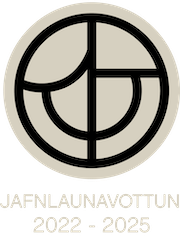Sjónræn söfnunarverkefni með fjölda markáreita - verkefni lokið
Fréttatilkynning verkefnisstjóra
While many studies have
involved visual search for single targets, studies involving search,or foraging, for many targets are far fewer. In three
work packages involving novel foragingparadigms, we have assessed how humans explore
multi-target environments, by involvingeye movement recordings and immersive virtual reality
technologies.
Overall, this project has cast light on (1) eye movement dynamics during multi-target foraging, both with finger and eye-gaze target selection, (2) the strategies used to explore complex visual environments composed of several items of differing value, and (3) individual differences in foraging strategy. By comparing the results to animal foraging research, we show how foraging strategies have evolved. Moreover, the examination of individual differences in oculomotor and attentional orienting have allowed identifying the optimal strategies for efficient multitarget foraging. Using cutting-edge technology for assessing attentional allocation in complex surroundings, this project has provided important insights into how observers orient in visual environments.
·
Information on how the results will be applied.
Given the short period that has been
dedicated to this project, we couldn’t examine all the
research questions that we had planned to test. We are
however confident that the work that
we have done so far can provide important information
about the evolution of foraging
behavior and about optimal strategies for efficient
human foraging. Potential applications
could involve medical practice (e.g., “foraging” for a
tumor on an X-ray) as well as video
games (e.g., optimal strategy for finishing a
time-limited video game based on a foraging
task). The use of 3D environment could be a first tool
for applying our work to the videogame field. And our collaboration (between
Dr. Tagu and Dr. Kristjánsson) will continue,
building on this good start, and we have already laid
the groundwork for this through the
generous support from this grant.
·
A list of the project’s outputs:
Articles submitted to international
peer-reviewed journals
- Tagu, J., &
Kristjánsson, Á. (under review). The selection balance: contrasting value, proximity
and priming in a multitarget foraging task. PsyArXiv, doi:10.31234/osf.io/48pzy
- Thornton, I. M., Tagu,
J., Zdravković, S., & Kristjánsson, Á. (in
revision). The predation game:
does dividing attention affect patterns of human
foraging? PsyArXiv, doi:10.31234/osf.io/xrb8j
Articles published in international
peer-reviewed journals:
- Tagu, J., &
Kristjánsson, Á. (2020). Dynamics of attentional and oculomotor orienting in
visual
foraging tasks. Quarterly
Journal of Experimental Psychology, doi:10.1177/1747021820919351
Communications in international conferences with
abstract published in peer-reviewed
journals:
- Tagu, J., &
Kristjánsson, Á. (accepted). The selection balance: how target value, proximity
and
priming shape search strategy and eye movement dynamics
during visual foraging. Vision Sciences Society
2021 Annual Meeting, 2021 May 21-26, St. Pete
Beach, FL, USA.
Heiti
verkefnis: Sjónræn söfnunarverkefni með fjölda
markáreita/ Visual foraging or multiple targets
Verkefnisstjóri: Jérôme Tagu, Háskóla Íslands
Tegund styrks: Nýdoktorsstyrkur
Styrktímabil: 2020 (hlaut styrk til þriggja ára en fékk
stöðu undir lok fyrsta styrkárs)
Fjárhæð styrks: 2,481 millj. kr. alls
Tilvísunarnúmer Rannís:
206744


